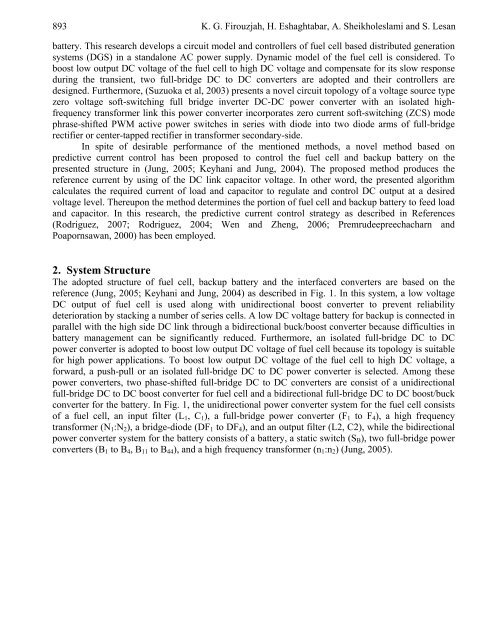European Journal of Scientific Research - EuroJournals
European Journal of Scientific Research - EuroJournals
European Journal of Scientific Research - EuroJournals
You also want an ePaper? Increase the reach of your titles
YUMPU automatically turns print PDFs into web optimized ePapers that Google loves.
893 K. G. Firouzjah, H. Eshaghtabar, A. Sheikholeslami and S. Lesan<br />
battery. This research develops a circuit model and controllers <strong>of</strong> fuel cell based distributed generation<br />
systems (DGS) in a standalone AC power supply. Dynamic model <strong>of</strong> the fuel cell is considered. To<br />
boost low output DC voltage <strong>of</strong> the fuel cell to high DC voltage and compensate for its slow response<br />
during the transient, two full-bridge DC to DC converters are adopted and their controllers are<br />
designed. Furthermore, (Suzuoka et al, 2003) presents a novel circuit topology <strong>of</strong> a voltage source type<br />
zero voltage s<strong>of</strong>t-switching full bridge inverter DC-DC power converter with an isolated highfrequency<br />
transformer link this power converter incorporates zero current s<strong>of</strong>t-switching (ZCS) mode<br />
phrase-shifted PWM active power switches in series with diode into two diode arms <strong>of</strong> full-bridge<br />
rectifier or center-tapped rectifier in transformer secondary-side.<br />
In spite <strong>of</strong> desirable performance <strong>of</strong> the mentioned methods, a novel method based on<br />
predictive current control has been proposed to control the fuel cell and backup battery on the<br />
presented structure in (Jung, 2005; Keyhani and Jung, 2004). The proposed method produces the<br />
reference current by using <strong>of</strong> the DC link capacitor voltage. In other word, the presented algorithm<br />
calculates the required current <strong>of</strong> load and capacitor to regulate and control DC output at a desired<br />
voltage level. Thereupon the method determines the portion <strong>of</strong> fuel cell and backup battery to feed load<br />
and capacitor. In this research, the predictive current control strategy as described in References<br />
(Rodriguez, 2007; Rodriguez, 2004; Wen and Zheng, 2006; Premrudeepreechacharn and<br />
Poapornsawan, 2000) has been employed.<br />
2. System Structure<br />
The adopted structure <strong>of</strong> fuel cell, backup battery and the interfaced converters are based on the<br />
reference (Jung, 2005; Keyhani and Jung, 2004) as described in Fig. 1. In this system, a low voltage<br />
DC output <strong>of</strong> fuel cell is used along with unidirectional boost converter to prevent reliability<br />
deterioration by stacking a number <strong>of</strong> series cells. A low DC voltage battery for backup is connected in<br />
parallel with the high side DC link through a bidirectional buck/boost converter because difficulties in<br />
battery management can be significantly reduced. Furthermore, an isolated full-bridge DC to DC<br />
power converter is adopted to boost low output DC voltage <strong>of</strong> fuel cell because its topology is suitable<br />
for high power applications. To boost low output DC voltage <strong>of</strong> the fuel cell to high DC voltage, a<br />
forward, a push-pull or an isolated full-bridge DC to DC power converter is selected. Among these<br />
power converters, two phase-shifted full-bridge DC to DC converters are consist <strong>of</strong> a unidirectional<br />
full-bridge DC to DC boost converter for fuel cell and a bidirectional full-bridge DC to DC boost/buck<br />
converter for the battery. In Fig. 1, the unidirectional power converter system for the fuel cell consists<br />
<strong>of</strong> a fuel cell, an input filter (L1, C1), a full-bridge power converter (F1 to F4), a high frequency<br />
transformer (N1:N2), a bridge-diode (DF1 to DF4), and an output filter (L2, C2), while the bidirectional<br />
power converter system for the battery consists <strong>of</strong> a battery, a static switch (SB), two full-bridge power<br />
converters (B1 to B4, B11 to B44), and a high frequency transformer (n1:n2) (Jung, 2005).

















